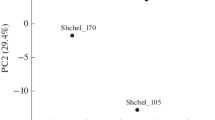Abstract
In the present study, the gas-chromatography—mass-spectrometry methods and classic bacteriology were used for investigation of microbiological diversity of underground waters in the Vorotilov deep well (East European platform, at 1500, 1900, 3200, 3800, and 4500 m). Mineralization of underground waters was high, 160–190 g/l. The data on microbial diversity (21–27 species of bacteria depending on fluid permeability) and total number of microorganisms (1–1000 g/ml) were obtained by gas-chromatography-mass-spectrometry analysis of specific biomarkers of microbial cells and by classical bacteriological cultivation on selectve media. Dominant groups among native microorganisms were the genera Clostridium, Corynebacterium, and Rhodococcus. Prevalence of heterotriophic processes was noted. The number of chemolithoautotrophic microorganisms was insignificant, but they increase when there is lower pollution of water. The number of chemolithoautotrophs was low. However, they increased when water pollution was lower (which was shown by classic bacteriology methods). The “detritus” type of the investigated subsurface ecosystem might result from contamination of underground water by a drilling solution. Biomarker monitoring along the column of a deep well reflected the hydrodynamics determined both by geological conditions and exploitation of the well.
Similar content being viewed by others
References
Balkwill, D.L. and Boone, D.R., Identity and Diversity of Microorganisms Cultured from Substrate Environments, in The Microbiology of the Terrestrial Deep Subsurface, New York, 1997.
Berdichevskaya, M.V., Specific Features of the Physiology of Rodococcus from the Developed Oil Deposits, Mikrobiologiya, 1989, no. 1, pp. 60–65.
Bergey’s Manual of Determinative Bacteria, Holt, J., Krieg, N., Sneath, P., Staley, J., and Williams, S., eds., Baltimore: Wilkins, 1994, 9th ed.
Frik, M.G., Koblova, A.Z., and Kuchina, E.L., Gases and Organic Substance of Rocks, in Glubokoe burenie v Puchezh-Katunkskoi impaktnoi strukture (Deep Drilling in the Puchezh-Katunkskaya Impact Structure), St. Petersburg, 1999.
Gal’chenko, V.F., Metanotrofnye bakterii (Methanotrophic Bacteria), Moscow, 2001.
Glubokoe burenie v Puchezh-Katunkskoi impaktnoi strukture (Deep Drilling in Puchezh-Katunkskaya Impact Structure), Masaitis, V.L. and Pevzner, L.A., Eds., St. Petersburg, 1999.
Ivshina, I.B., Alkanotrophic Rodococcus: Biodiversity, Detection, and Species Differentiation, in Mikrobnoe raznoobraie: sostoyanie, strategia sokhraneniya, ekologicheskie problemy: Materialy mezhdunarodnoi konferentsii, 8–11 oktyabrya 1996 g. (Proc. Int. Conf. on Microbial Diversity: State, Strategy of Maintenance, and Ecological Problems, Perm, October 8–11, 1996), Perm, 1996, p. 37.
Ivshina, I.B., Pshenichnov, R.A., and Oborin, A.A., Propanokislyayushchie rodokokki (Propane-Oxidizing Rhodoccus), Sverdlovsk, 1987.
Kondakova, G.V. and Bogatova, N.A., Hydrogen-Oxidizing Bacteria of Deep Waters of the Lithosphere, in Struktura, veshchestvo, istoriya litosfery Timano-Severoural’skogo segmenta: Informatsionnye materialy 12-i nauchnoi konferentsii, 5–7 dekabrya, 2003, Syktyvkar (Proceedings of the 12th Scientific Conference on Structure, Substance, and History of the Lithosphere of the Timano-Northern Ural Segment, Syktyvkar, December 5–7, 2003), Syktyvkar, 2003, pp. 126–128.
Kuhn, H., Frederich, U., and Fiechter, A., Defined Minimal Medium for a Thermophilic Bacillus sp. Developed by a Chemostat Pulse and Shift Technique, Eur. J. Appl. Microbiol. Biotechnol., 1979, no. 6, pp. 341–349.
Kuznetsov, S.I. and Dubinina, G.A., Metody izucheniya vodnykh organizmov (Methods of Study of Aquatic Organisms), Moscow, 1989.
Leigh, J.A., Mayer, F., and Wolfe, R.S., Acetogenium kivui, a New Thermophilic Hydrogen-Oxidizing, Acetogenic Bacterium, Arch. Microbiol., 1981, no. 129, pp. 275–280.
Oborin, A.A., Rubinshtein, L.M., Khmurchik, V.T., and Churilova, N.S., Kontseptsiya organizovannosti podzemnoi biosfery (Concept of Composition of the Underground Biosphere), Yekaterinburg, 2004.
Rabinovich, Yu.I. and Vorontsov, A.K., Chemical Composition and Gases of Underground Waters, in Glubokoe burenie v Puchezh-Katunkskoi impaktnoi strukture (Deep Drilling in the Puschezh-Katunkskaya Impact Structure), St. Petersburg, 1999.
Schlegel, H.G., Kaltwasser, H., and Gottschalk, G., Ein Summersverfahren zur Kultur wasserstoff oxidierender Bakterien: wackstumsphysiologische Untersuchungen, Arch. Microbiol., 1961, no. 38, pp. 209–222.
Stevens, T., Lithoautotrophy in the Subsurface, FEMS Microbiol. Rev., 1997, no. 20, pp. 327–337.
Verkhovtseva, N.V. and Kondakova, G.V., Microbiological Studies of Rocks and Underground Waters, in Glubokoe burenie v Puchezh-Katunkskoi impaktnoi strukture Deep Drilling in the Puchezh-Katunkskaya Impact Structure), St. Petersburg, 1999.
Verkhovtseva, N.V., Kondakova, G.V., and Rutkovskaya, O.M., Comparison of Allochtonic and Autochtonic Bacteria Isolated from Deep Aquifer of the Vorotilov Research Borehole, Int. Symposium on Subsurface Microbiology, Vail, Colorado, USA, August 22–27, 1999, 1999, p. 43.
Zhang, X., Mandelco, L., and Wiegel, J., Clostridium hydroxybenzoicum sp. nov., an Amino Acid-Utilizing, Hydroxybenzoate-Decarboxylating Bacterium Isolated from Methanogenic Freshwater Pond Sediment, Int. J. Syst. Bacteriol., 1994, no. 44, pp. 214–222.
Author information
Authors and Affiliations
Additional information
Original Russian Text © G.V. Kondakova, N.V. Verkhovtseva, G.A. Osipov, 2007, published in Vestnik Moskovskogo Universiteta. Biologiya, 2007, No. 2, pp. 23–29.
About this article
Cite this article
Kondakova, G.V., Verkhovtseva, N.V. & Osipov, G.A. Investigation of microbial diversity of underground waters in monitoring deep horizons of the Earth’s crust. Moscow Univ. Biol.Sci. Bull. 62, 69–75 (2007). https://doi.org/10.3103/S0096392507020058
Received:
Issue Date:
DOI: https://doi.org/10.3103/S0096392507020058




